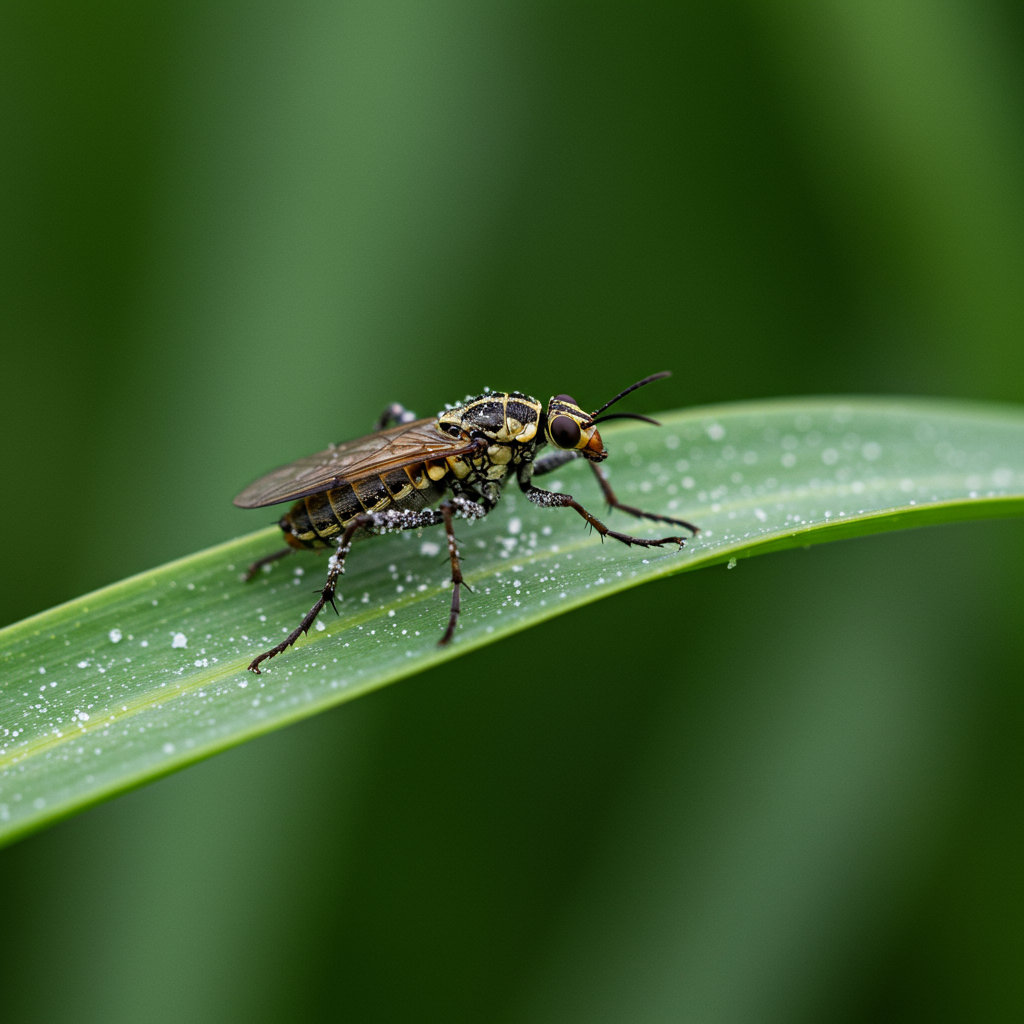Alarming research reveals a common agricultural chemical sprayed on food is severely impacting insect populations, raising concerns for pollination and ecosystem health. This finding adds a critical piece to the puzzle of widespread global insect decline.
A new study from Macquarie University in Australia highlights that chlorothalonil, one of the most used fungicides worldwide, significantly harms insect reproduction and survival. What’s particularly troubling is that these negative effects occur even at the low concentrations typically detected on fruits and vegetables we consume daily.
Unexpected Impact of Low-Dose Exposure
The Macquarie University research, published in Royal Society Open Science, specifically examined the effects of chlorothalonil on fruit flies (Drosophila melanogaster). These insects serve as a valuable model organism for biological studies. Researchers exposed fruit flies to chlorothalonil levels mirroring those found on produce like cranberries and wine grapes.
The results were stark and unexpected. Even at the lowest concentration tested, exposed flies experienced a dramatic 37 percent reduction in egg production compared to flies that were not exposed. This decline was far steeper than researchers anticipated at such minimal levels.
Lead author Darshika Dissawa noted the significant impact on reproduction, stating that “even the very lowest concentration has a huge impact.” Supervising author Associate Professor Fleur Ponton added, “We expected the effect to increase far more gradually with higher amounts.” The study found that chlorothalonil negatively affects fertility in both male and female flies.
Chlorothalonil: A Globally Common, Yet Controversial Chemical
Chlorothalonil is extensively applied to various crops globally, including orchards and vineyards in Australia and the United States. Its primary function is to prevent fungal diseases, often used proactively even when no disease is present.
However, the chemical’s status is not universal. In a significant contrast, chlorothalonil is banned for use in the European Union due to environmental and health concerns. This regulatory divergence highlights differing assessments of its risks despite its widespread application elsewhere. The Macquarie findings on insect harm contribute new data to this ongoing global discussion.
The Broader Agrochemical Crisis and Insect Decline
The research on chlorothalonil’s impact aligns with mounting evidence of a global insect population decline, often termed the “insect apocalypse.” Some regions have reported alarming drops exceeding 75 percent in recent decades. While multiple factors contribute, including habitat loss and climate change, extensive agricultural pesticide use is increasingly identified as a primary driver.
Pesticides, including fungicides, insecticides, and herbicides, don’t just affect target pests. Studies show they harm a wide range of non-target and beneficial insects. This happens through various mechanisms:
Direct Toxicity: Many pesticides are designed to disrupt insect nervous systems or exoskeletons, causing immediate death.
Sub-lethal Effects: Crucially, research indicates that concentrations well below lethal doses, like those tested in the Macquarie study and found environmentally, can severely impair insect behavior, development, and reproduction. A study published in Science, which examined over 1,000 agrochemicals including fungicides, demonstrated widespread damage to insect physiology and survival at sub-lethal levels.
Mixture Impacts: Insects are rarely exposed to just one chemical. Exposure to mixtures of compounds commonly found together in the environment can cause significant developmental delays and reduce egg-laying rates, amplifying negative effects.
Food Web Contamination: Pesticide residues contaminate plants and other insects, transferring through the food chain and impacting predator species.
Increased Vulnerability: Pesticide exposure can weaken insects, making them more susceptible to diseases and parasites.
Compounded Threats: Temperature and Habitat
The negative effects of agrochemicals are not isolated. Research further reveals a critical interaction with rising temperatures. Studies indicate that warmer conditions can significantly amplify the harm caused by chemical exposure, creating a “double jeopardy” for insect populations already stressed by pollution and habitat loss.
Habitat destruction is another major factor in insect decline. Pesticides contribute directly to this by damaging the plants and environments insects rely on for food and shelter. In the United States, discussions around interpreting the Endangered Species Act highlight the debate over whether harming habitat constitutes “harm” to a species, underscoring the critical link between chemical use and habitat integrity. Protecting habitat is essential for insect survival and recovery.
Cascading Impacts on Ecosystems
The decline of insect populations has profound consequences beyond the insects themselves. Insects provide vital ecosystem services:
Pollination: Many insects, including bees, flies, butterflies, and beetles, are essential pollinators for wild plants and a significant portion of global food crops. Reduced pollinator populations threaten agricultural yields and biodiversity.
Pest Control: Beneficial insects prey on agricultural pests, providing natural pest control that reduces the need for chemical interventions.
Nutrient Cycling: Insects contribute to soil health and nutrient cycling by breaking down organic matter.
Food Source: Insects form the base of food webs for countless other animals, including birds, fish, amphibians, and mammals. Declines in insect availability can lead to starvation and population drops in these dependent species. For instance, research on neonicotinoid pesticides has shown how harm to aquatic insects translates directly to reduced food availability for insectivorous birds, impacting their health and reproduction.
The Macquarie study, by showing how a widely used fungicide impairs insect reproduction at low doses, reveals a potentially overlooked mechanism contributing to these wider ecological impacts.
Towards Sustainable Solutions
Addressing the threat posed by chemicals like chlorothalonil requires a shift in agricultural practices and policy. The Macquarie researchers recommend reducing the frequency of chlorothalonil applications to allow insect populations time to recover between treatments.
More broadly, experts advocate for:
Filling Research Gaps: Despite extensive use, surprisingly few studies have examined chlorothalonil’s effects on insects. There is a critical need for more research focusing on sub-lethal effects, mixture impacts, and effects on a wider range of insect species at environmentally relevant concentrations.
Policy Reform: Regulatory frameworks need to better account for the non-lethal, long-term, and synergistic effects of pesticides on non-target organisms and their habitats. International coordination on chemical regulation could help address chemicals banned in some regions but widely used in others.
Adopting Agro-ecological Practices: Moving away from heavy reliance on synthetic pesticides and fertilizers towards holistic approaches like organic farming is crucial. Organic methods promote biodiversity, support beneficial insect populations, and enhance overall ecosystem health, fostering natural pest control and pollination without harmful chemicals.
The findings regarding chlorothalonil serve as a potent reminder that even common, seemingly benign agricultural inputs can have significant, hidden costs for the environment and the vital insects that underpin healthy ecosystems. Protecting these populations requires urgent attention and a commitment to more sustainable farming methods.
Frequently Asked Questions
What is chlorothalonil and why is it concerning for insects?
Chlorothalonil is one of the most widely used fungicides globally, applied to crops to prevent fungal diseases. Concerns arise because new research from Macquarie University shows it severely harms insect reproduction and survival, even at very low concentrations typically found on food. This suggests it could be contributing to the global decline of insect populations, including essential pollinators.
Where can I find more research on specific pesticide impacts on insects?
Research on pesticide impacts on insects is published in scientific journals focusing on ecology, environmental science, toxicology, and entomology, such as Royal Society Open Science and Science. University research centers like Macquarie University and environmental organizations also publish findings and summaries. Searching academic databases with terms like “pesticide insect toxicity,” “fungicide non-target effects,” “insect decline agrochemicals,” or specific chemical names like “chlorothalonil insects” can yield relevant studies.
What alternatives exist to broad-spectrum fungicides like chlorothalonil?
Alternatives include adopting integrated pest management (IPM) strategies that combine multiple approaches like monitoring, using disease-resistant plant varieties, improving soil health, and applying targeted biopesticides or biological controls only when necessary. Organic farming practices avoid synthetic chemicals entirely, relying on natural processes, beneficial insects, and diverse crop systems to manage diseases and pests while promoting overall insect biodiversity and ecosystem health.
Conclusion
The new research identifying chlorothalonil as a hidden threat to insect reproduction at low doses underscores the complex and often unexpected ways agricultural chemicals impact ecosystems. This finding is not isolated but contributes to the alarming global narrative of insect decline driven by widespread pesticide use, habitat loss, and climate change. Recognizing the critical role insects play in pollination, food webs, and ecosystem health necessitates urgent action. By supporting further research, promoting stronger regulatory oversight, and transitioning towards sustainable and organic farming practices, we can mitigate the harm caused by chemicals like chlorothalonil and work to protect the vital insect populations the planet depends on.
Word Count Check: 1145




